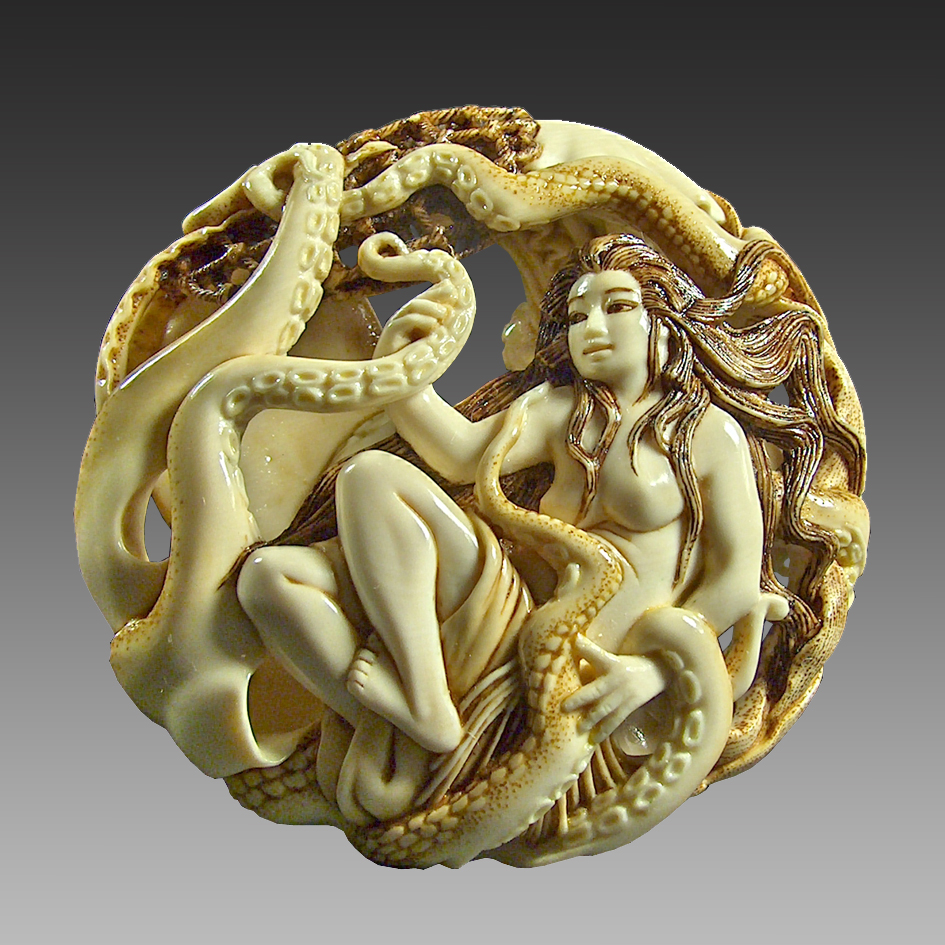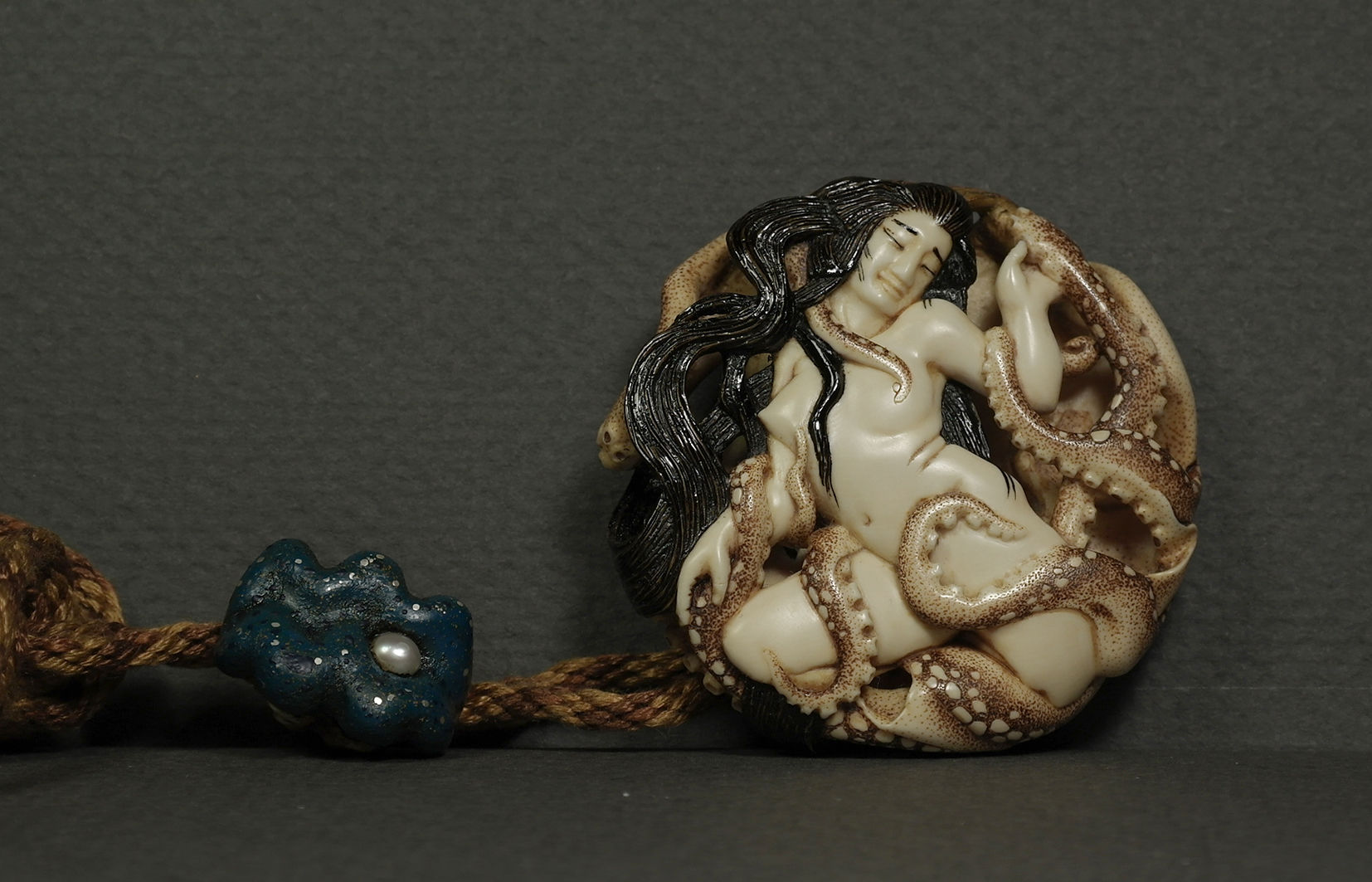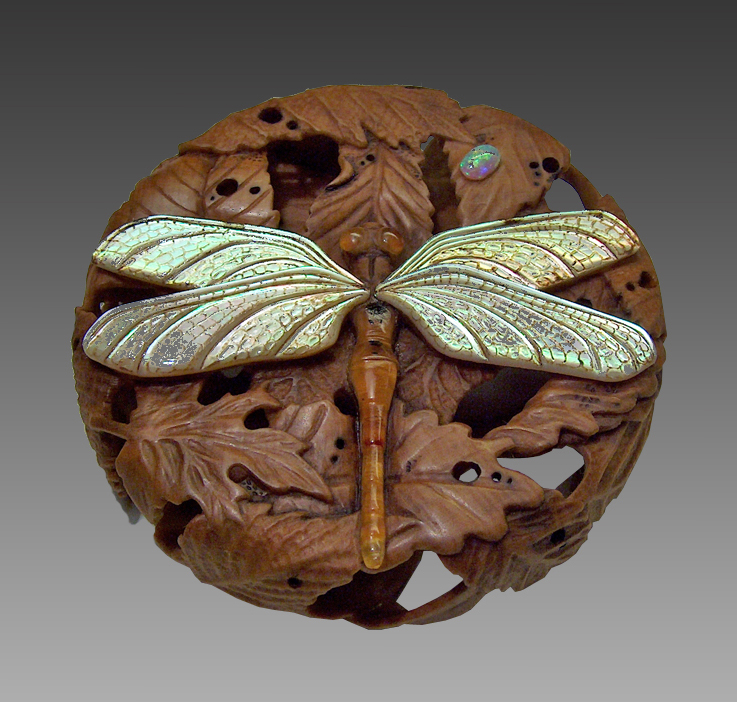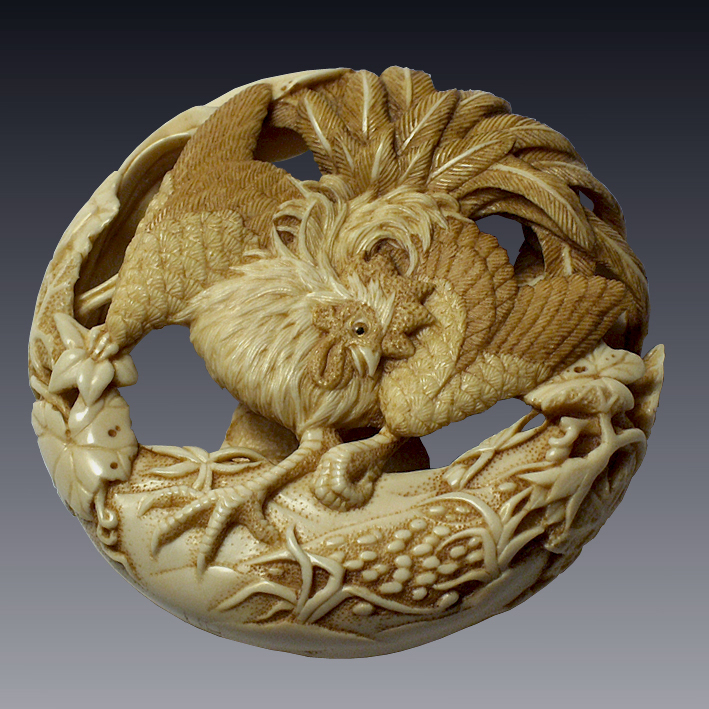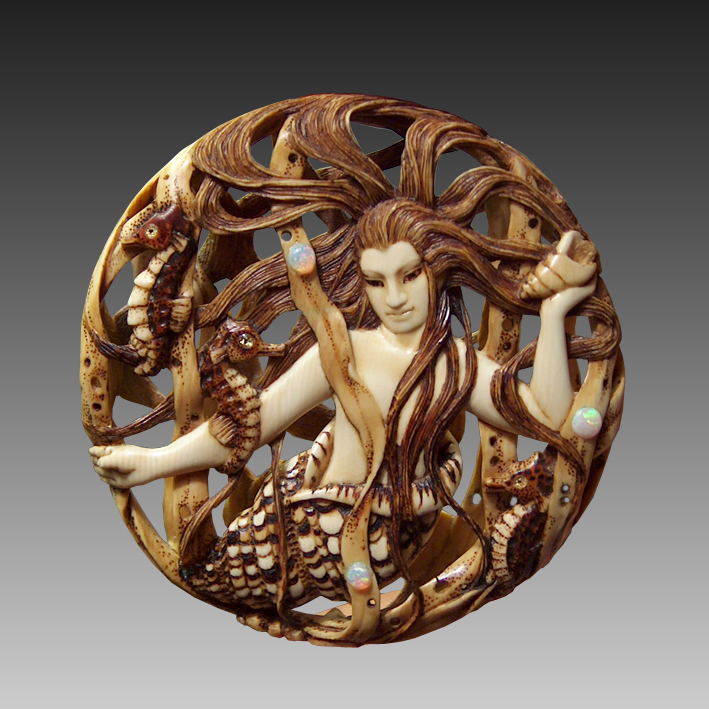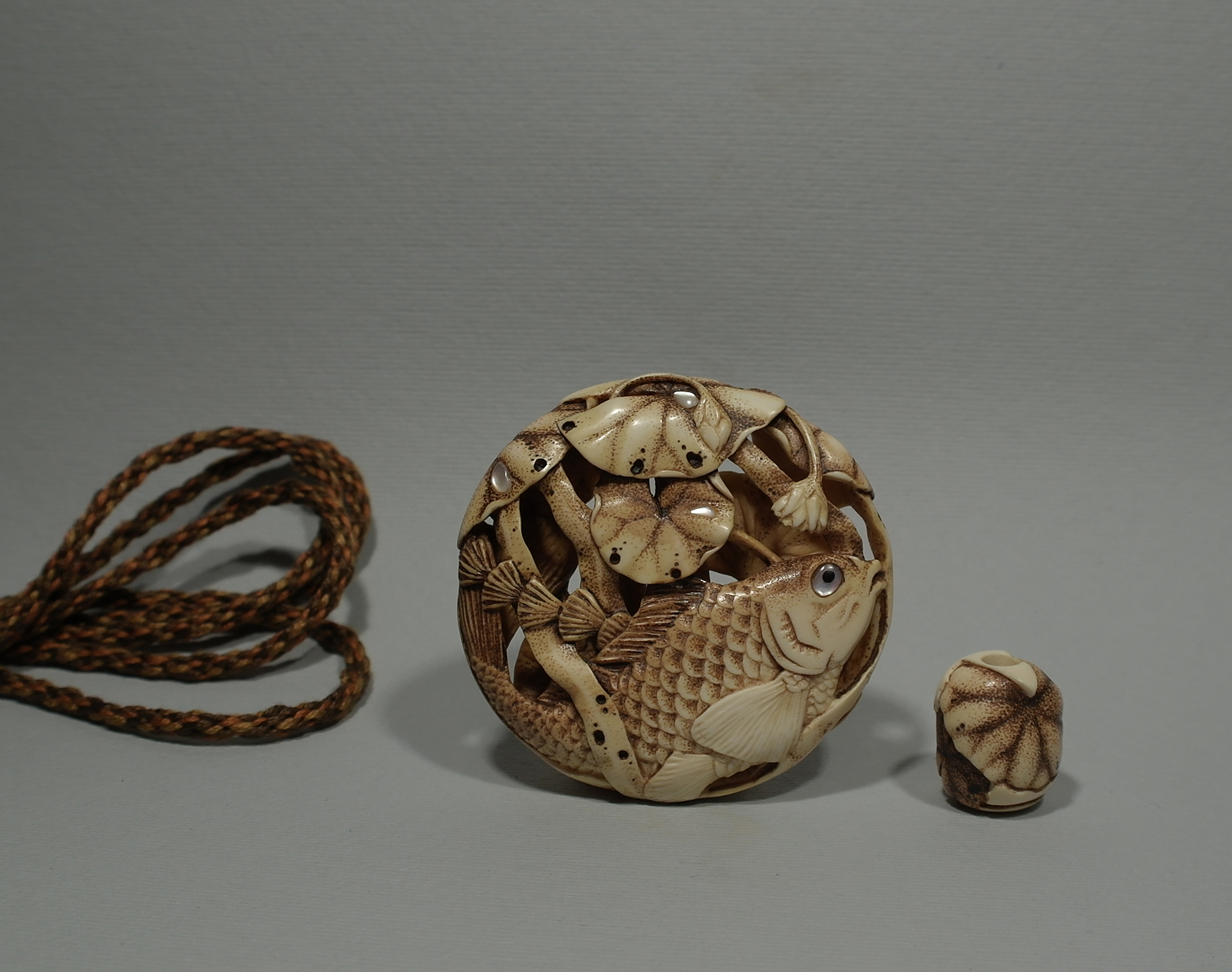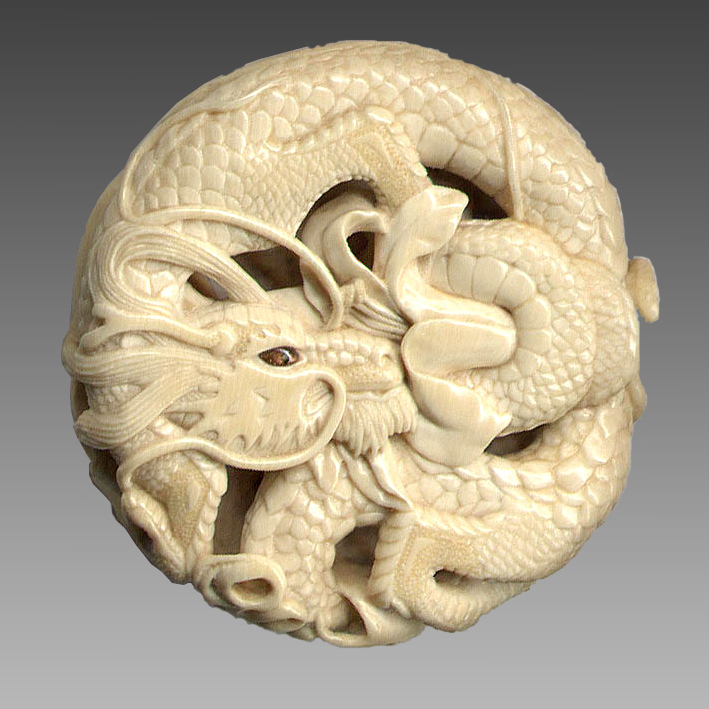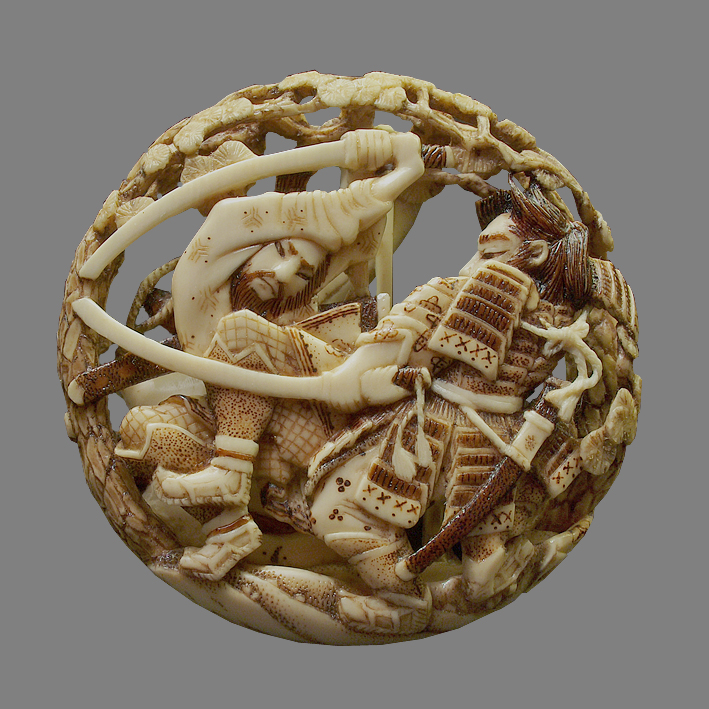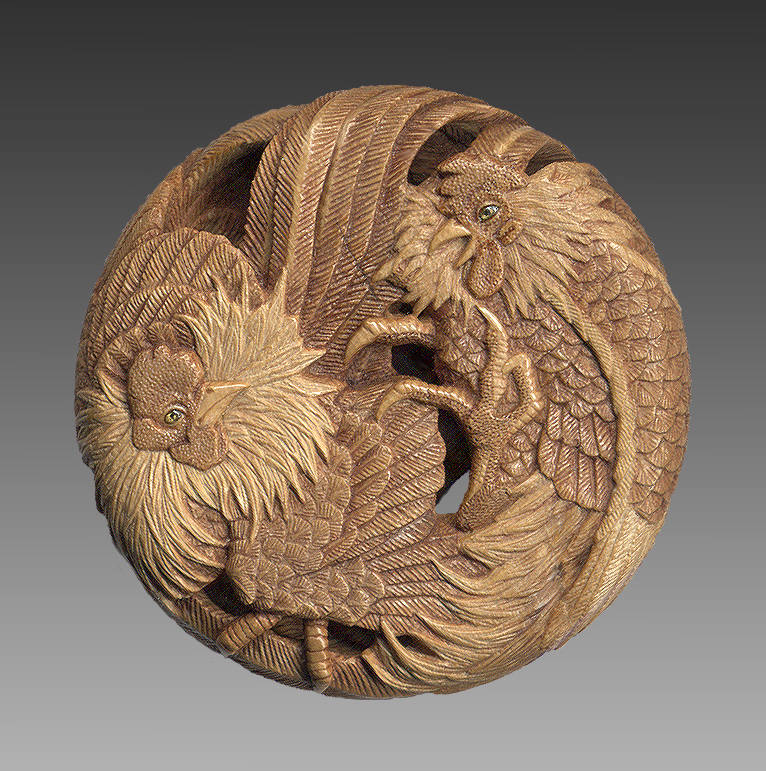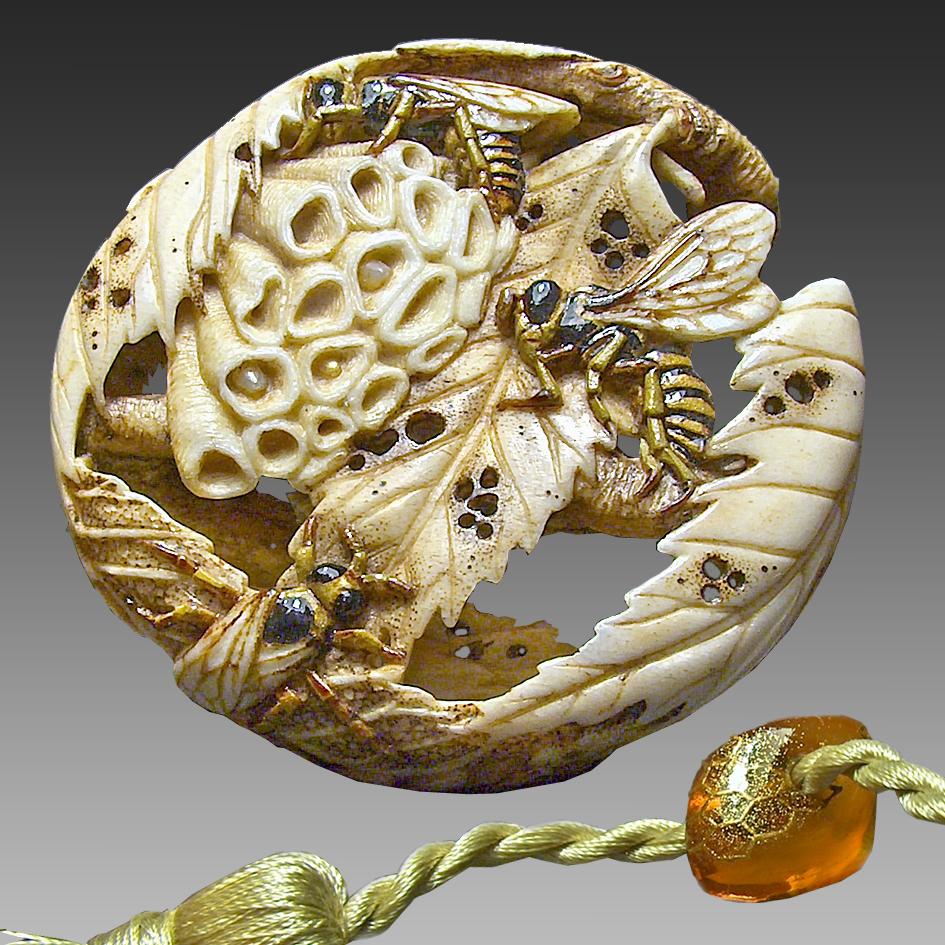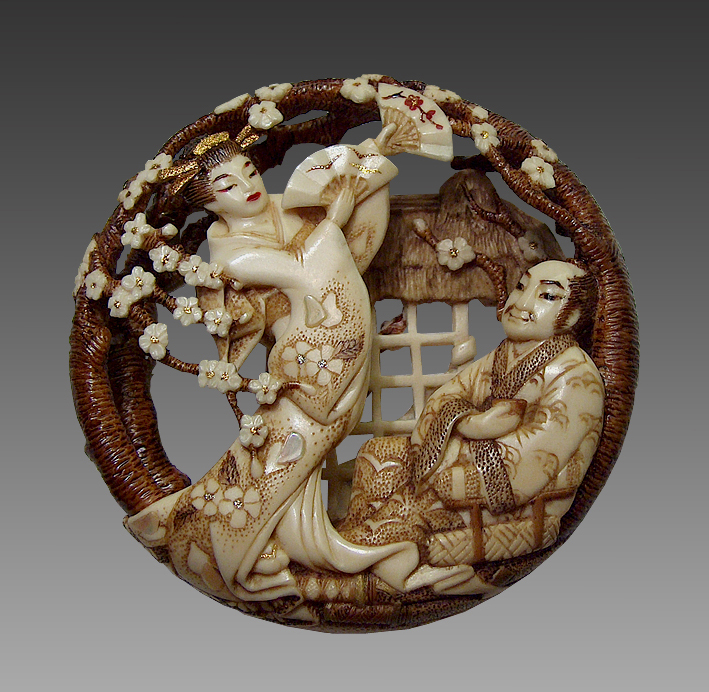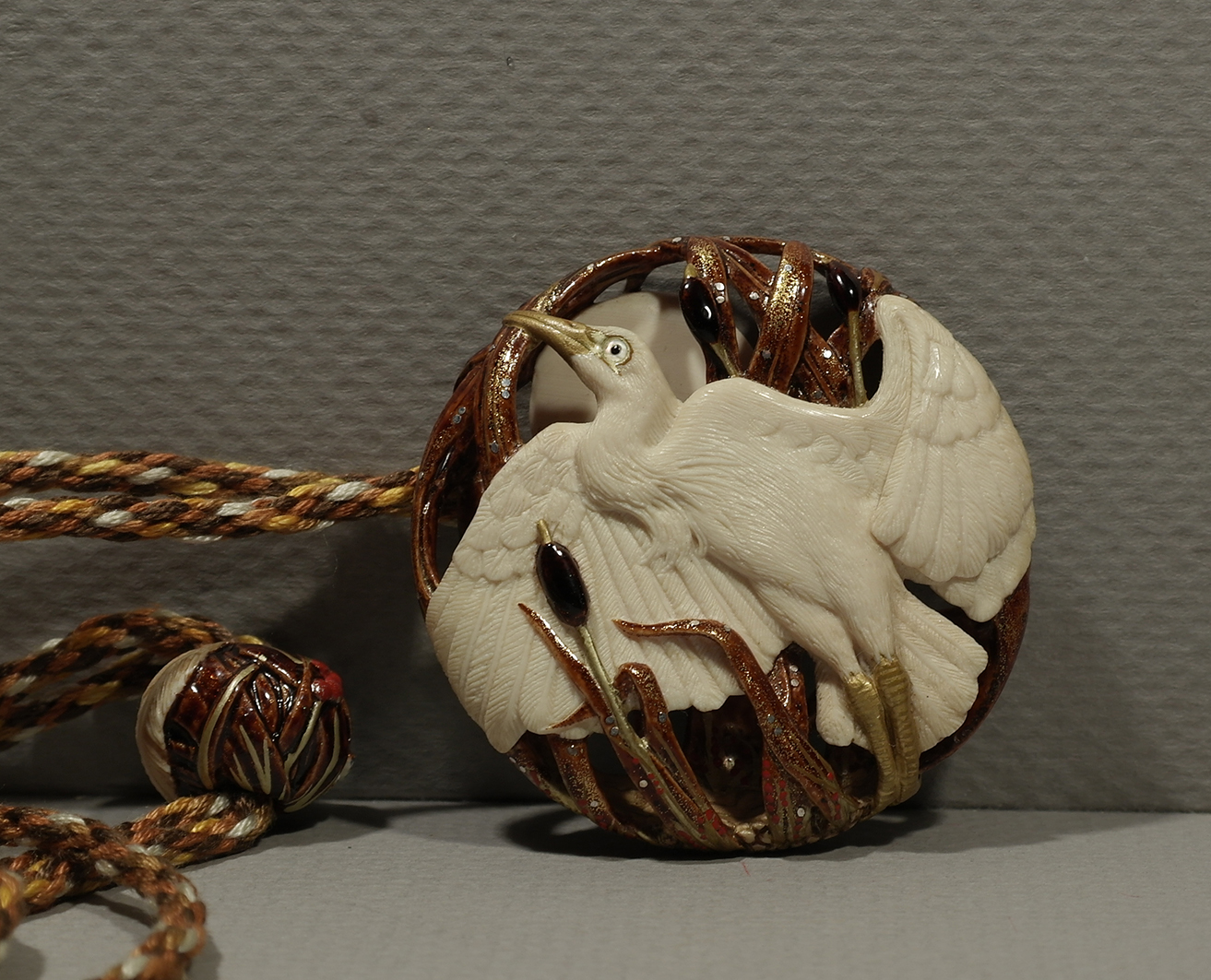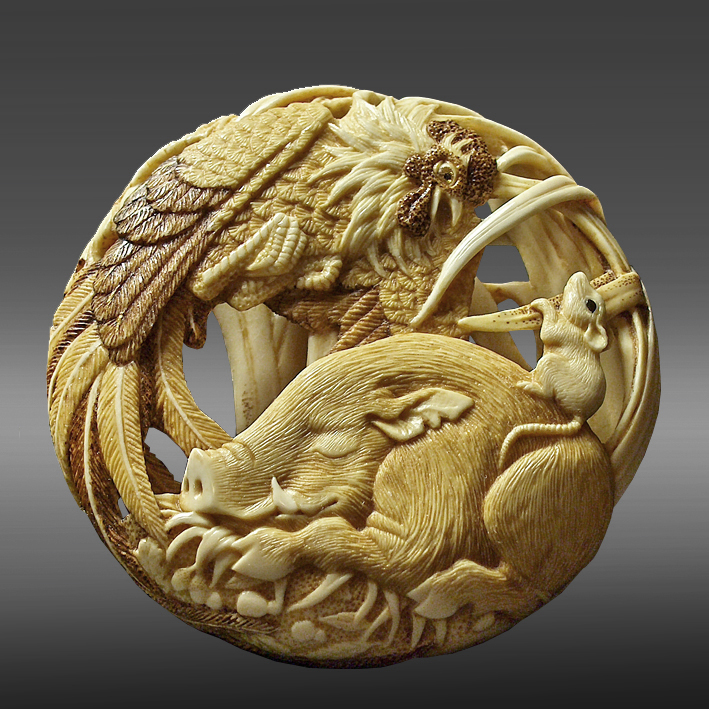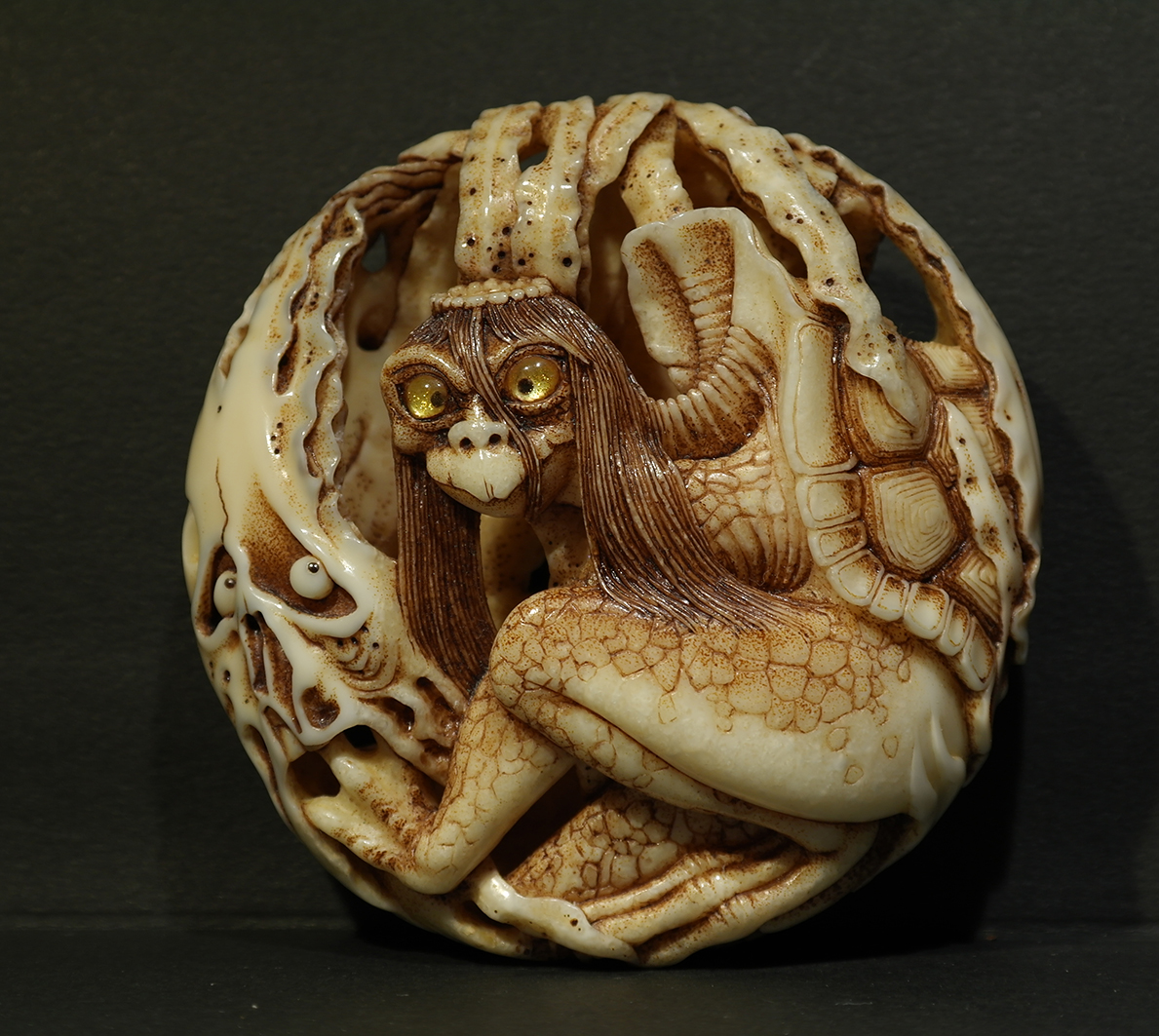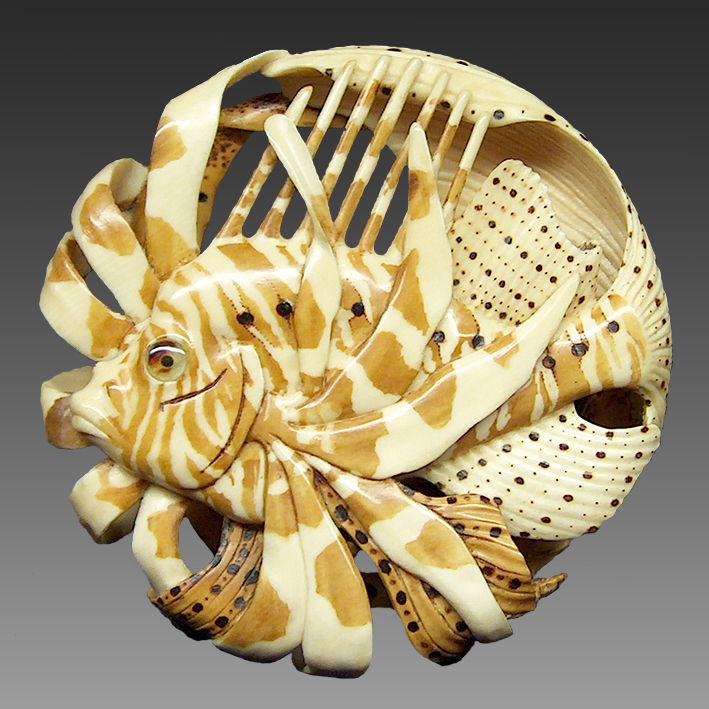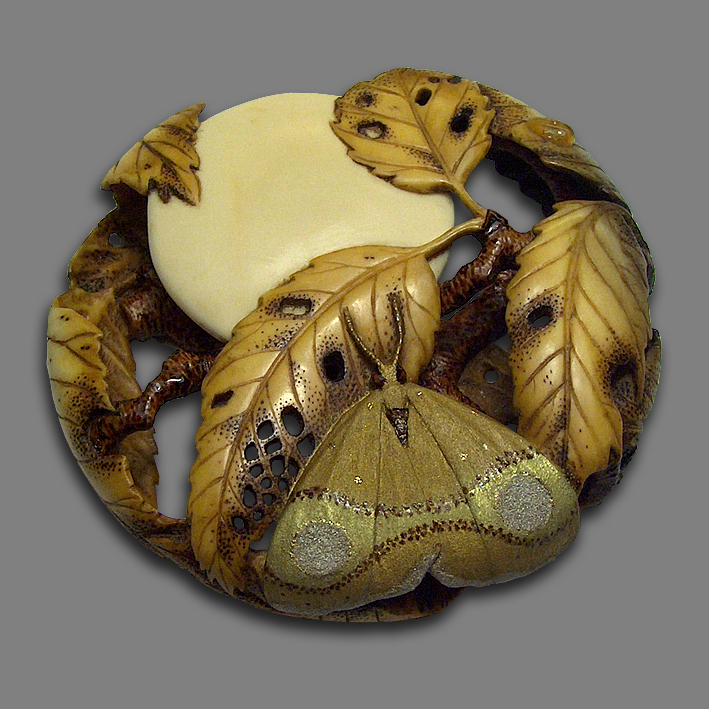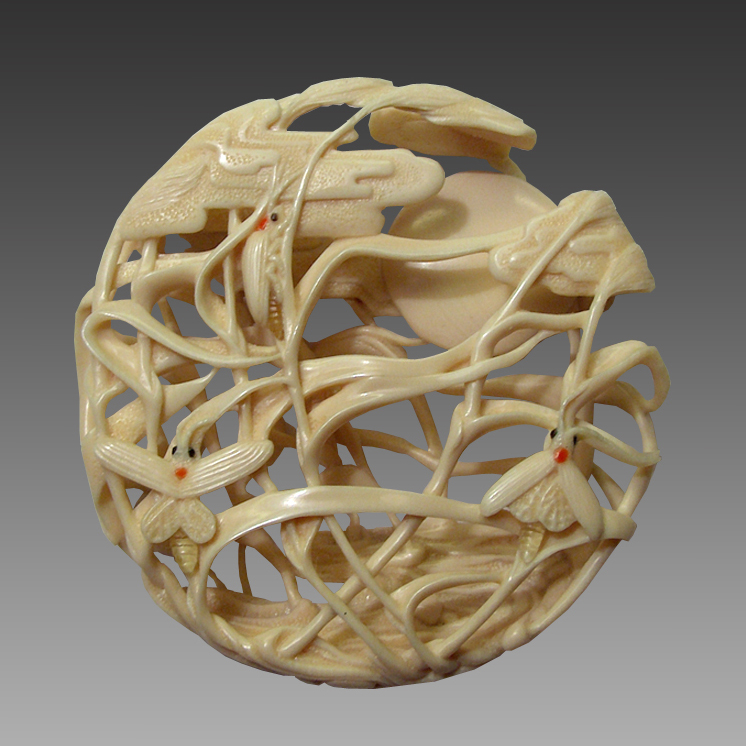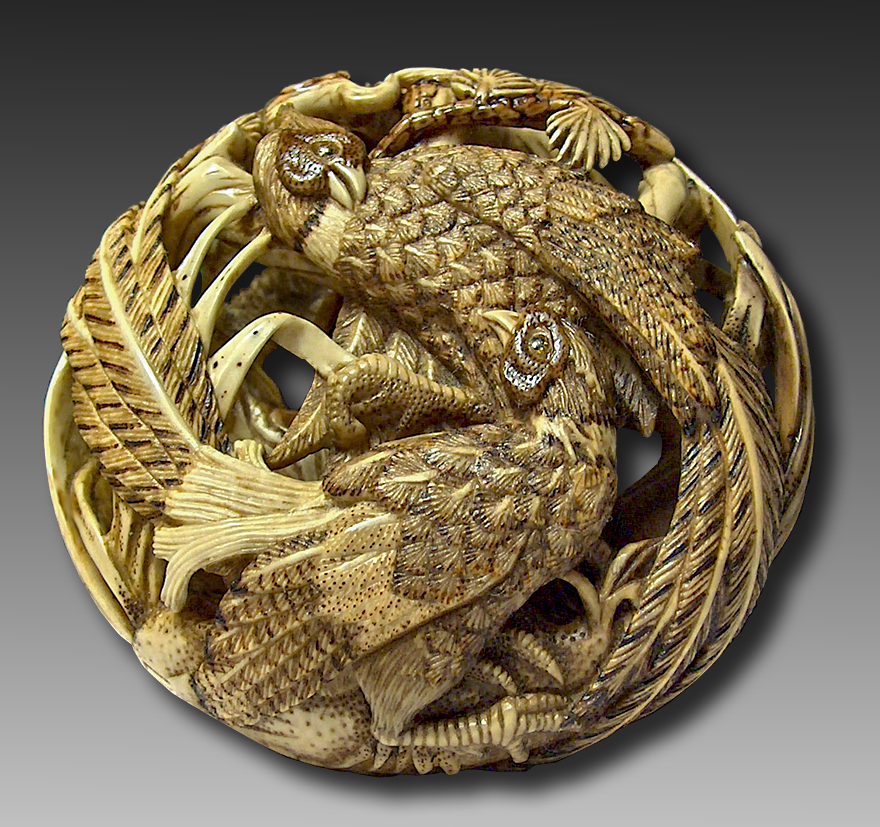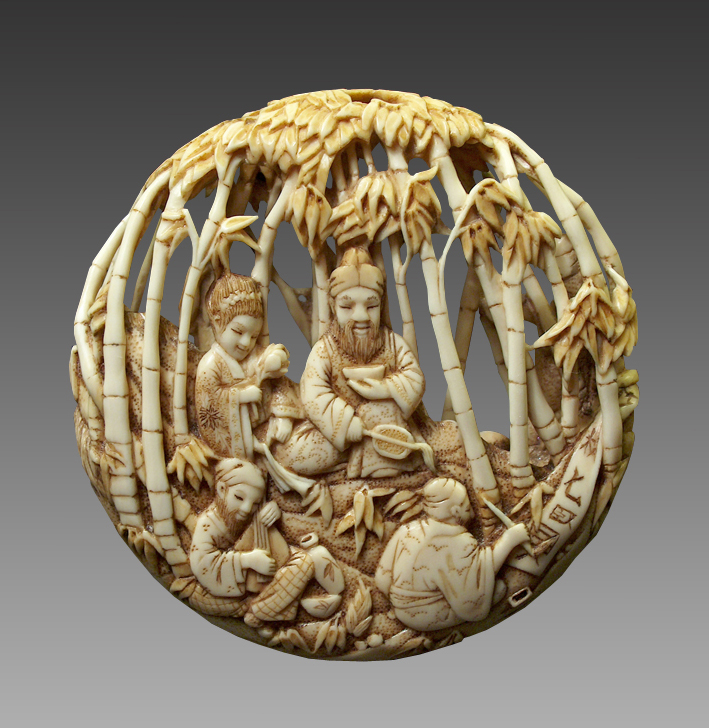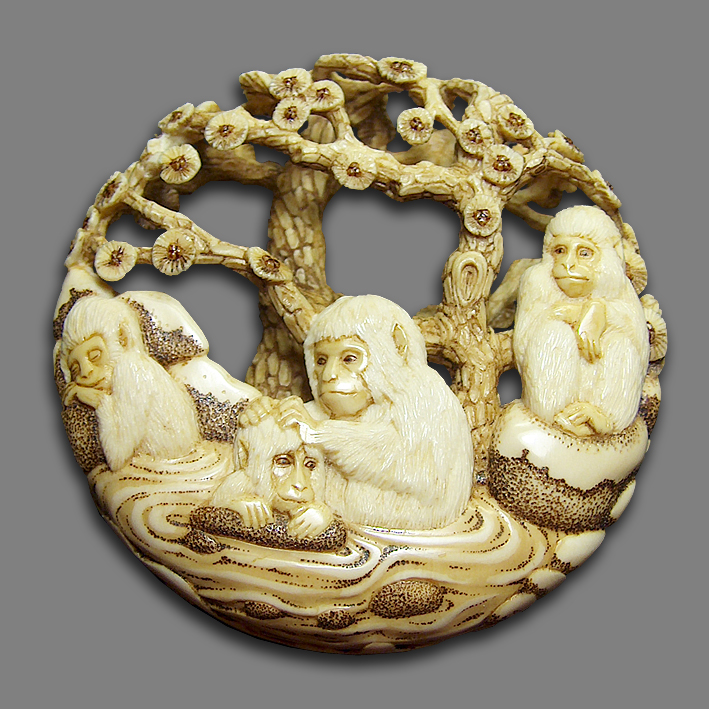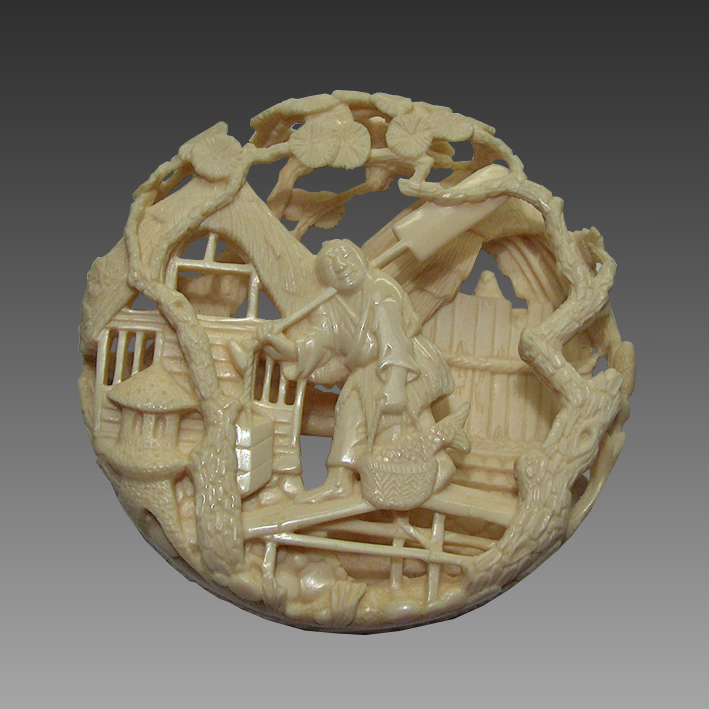RYUSA NETSUKE
AMA
6 images
Ryusa style netsuke “Ama&Octopus” has been carved from mammoth tusk, stained with Yashabushi, Urushi lacquer, Mother-of-pearl and black buffalo horn inlaid eye of Octopus. 5,5 cm across, the thickness is 2 cm, 2011. Germany, private collection of Theodor Hahn.
![AMA]()
AMA AND OCTOPUS
10 images
Ryusa netsuke has been carved from fossil mammoth tusk, stained with Yashabushu, burning needle, Japanese Urushi lacquers Kuro-nakanuri and Seshime, shell inlaid eye. 2 inches across. 2021
![AMA AND OCTOPUS]()
AUTUMN
3 images
“Autumn”” was carved from box-wood, inlays were done from golden amber (body of dragonfly and its eyes), white mother-of-pearl (its wings) and opal stone (as a frozen dew) . Its size is 2 inches across and ½ inch thick. The loop for the cord was done opposite himotoshi, as a grass. December, 2007. UK, private collection.
![AUTUMN]()
BANTAM AND SEEDS
8 images
“Bantam and Seeds” has been carved from mammoth tusk, stained with Yashabushi and Walnut ink, inlaid eyes, its size is 2 inches across and the thickness is ½ inch. 2010, USA
![BANTAM AND SEEDS]()
BENZAITEN
3 images
“Benzaiten” was carved from ivory mammoth tusk, inlaid eyes, 2 inches across and ½ inch thick. This netsuke was colored with Kuchinashi, Yashabushi, Silver Nitrate, Walnut dye and burning needle. The loop for the cord was done opposite himotoshi as a curl. Two opals stones were inlaid. 2008 USA, private collection.
![BENZAITEN]()
BLOSSOMING CHERRY BRANCH
2 images
“Moon, Clouds and Blossoming Cherry Branch” was carved from ivory walrus tusk, stained with Yshabushi, walnut ink and burning needle. Its size is 2 inches across and ½ inch thick. The loop for the cord was done opposite himotoshi. 2008 UK, private collection.
![BLOSSOMING CHERRY BRANCH]()
CARP AMONG THE LOTUS LEAVES
11 images
Ryusa netsuke "Carp under the lotus leaves preparing to jump" with ojimi in the style of Shishiabori. The ryusa is made from a piece of mammoth tusk, 5.2 cm in diameter (2 inches) and 1.25 cm thick (1/2 inch), tinted with Yashabushi, burned with a needle, mother-of-pearl for inlays. 2023. 鯉の滝登り - Koi no takinobori - a carp that ascends the waterfall through the Dragon Gate and after swimming up the Yellow River, turns into a dragon. It is a symbol of significant success. Therefore, this fish is called the king of all fish, it is considered a symbol of power and superiority. And also the carp symbolizes the desire for ambitious goals and serves as an example of success achieved through overcoming difficulties and obstacles. In the Buddhist tradition, carp means fearlessness and courage. And since carps can live up to 200 years, they also symbolize longevity. In May of each year, colorful rag carps are put on display in Japan to celebrate the traditional tango no sekku (Boys' Day), and cloth carps flutter all over Japan, a symbol of wishing boys to be strong and successful. "Koi-nobori" symbolizes the wish for boys to grow up into beautiful men and easily overcome all difficulties. The length of the carp depends on the age of the children, the largest symbolizes the head of the family. 2023. Available for purchase.
![CARP AMONG THE LOTUS LEAVES]()
DRAGON AND LILY
2 images
"Dragon falls in love with the Lilly", shorter "Dragon and Lily”, 2 inches across and ½ inch thick. There are tail of the dragon,coiling in the waves of the passion for the lily on the the reverse side. This netsuke was done from the mammoth ivory, the amber inlaid eye. The loop for the cord was carved opposite himotoshi. 2006 UK, private collection.
![DRAGON AND LILY]()
DRAGONFLY AND GRASSHOPPER
3 images
“Dragonfly and Grasshopper” was carved from ivory mammoth tusk, four amber inlaid eyes, 2 inches across and ½ inch thick. The loop for the cord was done opposite himotoshi. 2006 USA, private collection.
![DRAGONFLY AND GRASSHOPPER]()
FIGHT OF SAMURAIS
4 images
“Fight of two Samurais” has been carved from ivory mammoth tusk, colored with Yashabushi , Walnut ink and Seshime- and Rose-Urushi. Its size is 2 inches across and ½ inch thick. The loop for the cord was done opposite himotoshi. 2008 UK, private collection.
![FIGHT OF SAMURAIS]()
FIGHTING ROOSTERS
2 images
“Fighting Roosters” was carved from light brown mammoth tusk, amber inlaid eyes, 2 inches across and ½ inch thick. This netsuke was colored with tea dye. The loop for the cord was done opposite himotoshi. 2006 UK, private collection.
![FIGHTING ROOSTERS]()
FOREST WASPS
2 images
Ryusa style netsuke “Forest wasps” has been carved from elk horn, bleached, stained with Yashabushi, lacquered with Roiro Urushi, gold lacquer, ojime was done from amber, honeycomb was with gold lacquer and Nashiji flackes. 2011. The Ukraine,, private collection.
![FOREST WASPS]()
GEISHA AND SAMURAI
5 images
“Geisha and Samurai” has been carved from ivory mammoth tusk, colored with Yashabushi ; Seshime- ,Rose-, Roiro- and Red Urushi. 5 petals were inlaid on the kimono of Geisha from reddish mother-of-pearl. Gold Nashiji fine flaks, Silver Nashiji fine flaks, Fundame gold reddish, Fundame gold bluish. Its size is 2 inches across and ½ inch thick. The loop for the cord was done opposite himotoshi. 2008 Russia, private collection.
![GEISHA AND SAMURAI]()
HERON
8 images
In Japanese art, the heron symbolizes elegance, purity and grace. These birds are often depicted in various art forms, including paintings, pottery and kimono designs, reflecting the beauty and cultural traditions of Japan. A flying heron symbolizes good luck and prosperity, and also reflects the desire for heights of spirit, physical and spiritual purification. The flying heron, like the crane, is a bird that is perceived as capable of reaching heavenly heights, symbolizing ambition and the ability to achieve high goals. Ryusa netsuke "Heron" was carved from mammoth ivory, 2 inches in diameter, half an inch thick, Urushi lacquers, gold, silver and koban (an alloy of gold and silver with a greenish tint), inlaid eyes with mother of pearl and black water buffalo horn, braided cord and ojimi mammoth tusk with Urushi lacquers. 2024. Russia, private collection.
![HERON]()
IDEAL HARMONY
2 images
“IDEAL HARMONY” has been carved from ivory mammoth tusk, colored with Yshabushi and Walnut ink, amber and black buffalo horn inlaid eyes. Its size is 2 inches across and ½ inch thick. The loop for the cord was done opposite himotoshi. 2010. USA, private collection.
![IDEAL HARMONY]()
KAPPA AND GHOSTS
8 images
This Ryusa netsuke was carved from walrus tusk, its diameter is 7.1 cm, its thickness is 2.7 cm. Kappa is a child drowned by an oversight of adults, a child doomed to stay in the dusk of lakes, without love, care, a child offended by everyone and everything, therefore in Japanese mythology all Kappa are very evil and harmful creatures, if Kappa is given the opportunity drag someone to the bottom, it will be so. UK, the owner is Andy Jordan.
![KAPPA AND GHOSTS]()
LION-FISH
6 images
“Lion-Fish” was carved from ivory mammoth tusk, inlaid eyes was done from a white/brown shell, black water buffalo horn and amber, the body of fish was stained with walnut ink, black points on the fish was done with silver nitrate and burning needle, 2 inches across and ½ inch thick. The loop for the cord was done opposite himotoshi. 2006 UK, private collection.
![LION-FISH]()
MOON, LEAVES AND MOTH
5 images
“Moon, Leaves and Moth” has been carved from ivory mammoth tusk, colored with Yashabushi ; Seshime- , Roiro- Urushi. The Moth was covered with different powders, Fundame gold reddish, Fundame gold bluish and Fundame silver. A dew drop was carved from Baltic amber. Its size is 2 inches across and ½ inch thick. The loop for the cord was done opposite himotoshi. 2008 Russia, private collection.
![MOON, LEAVES AND MOTH]()
MOON, REEDS AND FIREFLIES
3 images
“Moon, reeds and fireflies” was carved from ivory mammoth tusk, inlays were done from black water buffalo horn and red apple coral, the glows were done from golden amber. Its size is 2 inches across and ½ inch thick. The loop for the cord was done opposite himotoshi. 2007 USA, private collection.
![MOON, REEDS AND FIREFLIES]()
PHEASANTS
12 images
Ryusa style netsuke, “Fighting Pheasants” has been carved from mammoth tusk (dark ivory), its diameter is 5 cm, 2.2 cv thickness, stained with walnut ink, Yashabushi, burning needle, Urushi lacquer, gold and amber inlaid eyes.
![PHEASANTS]()
SEVEN WORTHIES
6 images
“Seven Worthies in the bamboo grove” is very famous legend in Japan and China, has been carved from ivory mammoth tusk, colored with Yashabushi and Walnut ink. Its size is 2 inches across and ½ inch thick. The loop for the cord was done opposite himotoshi. 2008 UK, private collection.
![SEVEN WORTHIES]()
SNOWY MONKEYS
9 images
“Snowy Monkeys” was carved from ivory mammoth tusk, stained with Yshabushi, Nashiji-Urushi and burning needle. Its size is 2 inches across and ½ inch thick. The loop for the cord was done opposite himotoshi. 2008 UK, private collection.
![SNOWY MONKEYS]()
VILLAGE
2 images
On the front side there are a house, a bridge, a fisherman with an oar and a basket with a fish and a tree, on the reverse side there are a barn with two birds stealing seeds, a gate with fragment of fence and a tree. They are traditional Japanese objects, have been carved from ivory mammoth tusk, 2 inches across and ½ inch thick. The loop for the cord was done opposite himotoshi. 2007 UK, private collection.
![VILLAGE]()
WATER MILL
7 images
Water-mill, Moon, waves are traditional Japanese objects, have been carved from ivory mammoth tusk, 2 inches across and ½ inch thick. The loop for the cord was done opposite himotoshi under Moon. 2007 UK, private collection.
![WATER MILL]()
